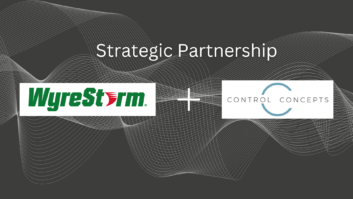With the rise of the hybrid work model, meeting rooms today must be equipped to support participants joining from anywhere in the world. For this, it’s essential that every room is fitted with a well-integrated collaboration system that ensures seamless connections between remote and in-person participants. The continuous advancement of technology means that manufacturers must constantly innovate, while workplaces need to remain flexible to adapt to these changes.
In the fast-paced AV industry, a wide array of digital tools are available to facilitate collaboration and help teams work more efficiently across multiple locations. Increasingly in recent years, there’s a strong emphasis on sustainability, particularly in the adoption of environmentally friendly devices and energy-efficient technologies. For example, multifunctional meeting rooms are designed to meet a variety of needs with fewer spaces, using programmable settings to maximise efficiency. This approach allows organisations to reduce the number of rooms required, cutting down on both energy use and operational costs.
 GREEN TECHNOLOGIES
GREEN TECHNOLOGIES
The integration of energy-saving devices and green technologies, such as automated display management and digital collaboration platforms, can significantly reduce both energy consumption and waste. In AVoIP systems, for instance, multifunctional data transmission can be achieved using a single cable, which helps to minimise the need for extensive cabling and installation. Thoughtfully designed equipment lists can also reduce the use of unnecessary packaging materials, mounts, and cables, further promoting sustainable practices within the AV industry.
Sustainable solutions in meeting rooms go beyond energy-efficient devices. Displays can automatically switch to standby mode when no meetings are taking place and thus save significant amounts of power over time. Occupancy Sensor (OCS) systems can detect whether a room is in use, and shut down all systems if no one is present, further enhancing energy conservation. Automating the control of lighting, displays, and other devices boosts energy efficiency and is also critical to achieving long-term sustainability goals. Reducing unnecessary energy usage when rooms are empty helps lower the overall carbon footprint of an organisation.
In addition to these energy-saving measures, establishing a robust technological infrastructure is crucial for enabling effective remote collaboration. For example, remote access to servers and production tools allows teams to work together seamlessly, regardless of their physical location. This kind of setup enhances productivity while significantly reducing the need for business travel, which in turn decreases the environmental impact of travel.
By adopting energy-efficient and flexible AV solutions, organisations can foster more sustainable practices while improving collaboration across geographically distributed teams. The use of automated systems, energy-saving devices and advanced collaboration platforms play a vital role in reducing environmental impact, and support a more sustainable future for the workplace.







